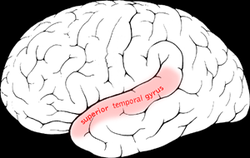Superior temporal gyrus
| Superior temporal gyrus | |
|---|---|

Superior temporal gyrus of the human brain.
|
|

Right temporal lobe (shown in green). Superior temporal gyrus is visible at the top of the green area.
|
|
| Details | |
| Part of | Temporal lobe |
| Artery | middle cerebral |
| Identifiers | |
| Latin | gyrus temporalis superior |
| NeuroNames | hier-118 |
| NeuroLex ID | Superior temporal gyrus |
| TA | A14.1.09.138 |
| FMA | 61905 |
|
Anatomical terms of neuroanatomy
[]
|
|
The superior temporal gyrus is one of three (sometimes two) gyri in the temporal lobe of the human brain, which is located laterally to the head, situated somewhat above the external ear.
The superior temporal gyrus is bounded by:
The superior temporal gyrus contains several important structures of the brain, including:
The superior temporal gyrus contains the primary auditory cortex, which is responsible for processing sounds. Specific sound frequencies map precisely onto the primary auditory cortex. This auditory (or tonotopic) map is similar to the homunculus map of the primary motor cortex. Some areas of the superior temporal gyrus are specialized for processing combinations of frequencies, and other areas are specialized for processing changes in amplitude or frequency. The superior temporal gyrus also includes the Wernicke's area, which (in most people) is located in the left hemisphere. It is the major area involved in the comprehension of language. The superior temporal gyrus (STG) is involved in auditory processing, including language, but also has been implicated as a critical structure in social cognition.
The superior temporal gyrus has been involved in the perception of emotions in facial stimuli.) Furthermore, the superior temporal gyrus is an essential structure involved in auditory processing, as well as in the function of language in individuals who may have an impaired vocabulary, or are developing a sense of language. The superior temporal gyrus has been discovered to be an important structure in the pathway consisting of the amygdala and prefrontal cortex, which are all involved in social cognition processes. Including the superior temporal gyrus, areas more anterior and dorsal within the temporal lobe have been linked to the ability of processing information the many changeable characteristics of a face. Research conducted with the use of neuroimaging have found patients with schizophrenia have structural abnormalities in their superior temporal gyrus.
The superior temporal gyrus (STG) is important for language comprehension, but studies also suggest that is plays a functional role in the cocktail party scene. A magnetoencephalography study was conducted on participants that were exposed to 5 differing listening conditions each with a different level of background noise. It was discovered that the STG has a strong connection with the attended speech stream in a cocktail party setting. When the attended speech stream wasn’t disrupted by background noise a bilateral connection was displayed, but as more background noise was introduced the connection became left-hemisphere dependent.
Position of superior temporal gyrus (shown in red).
...
Wikipedia
